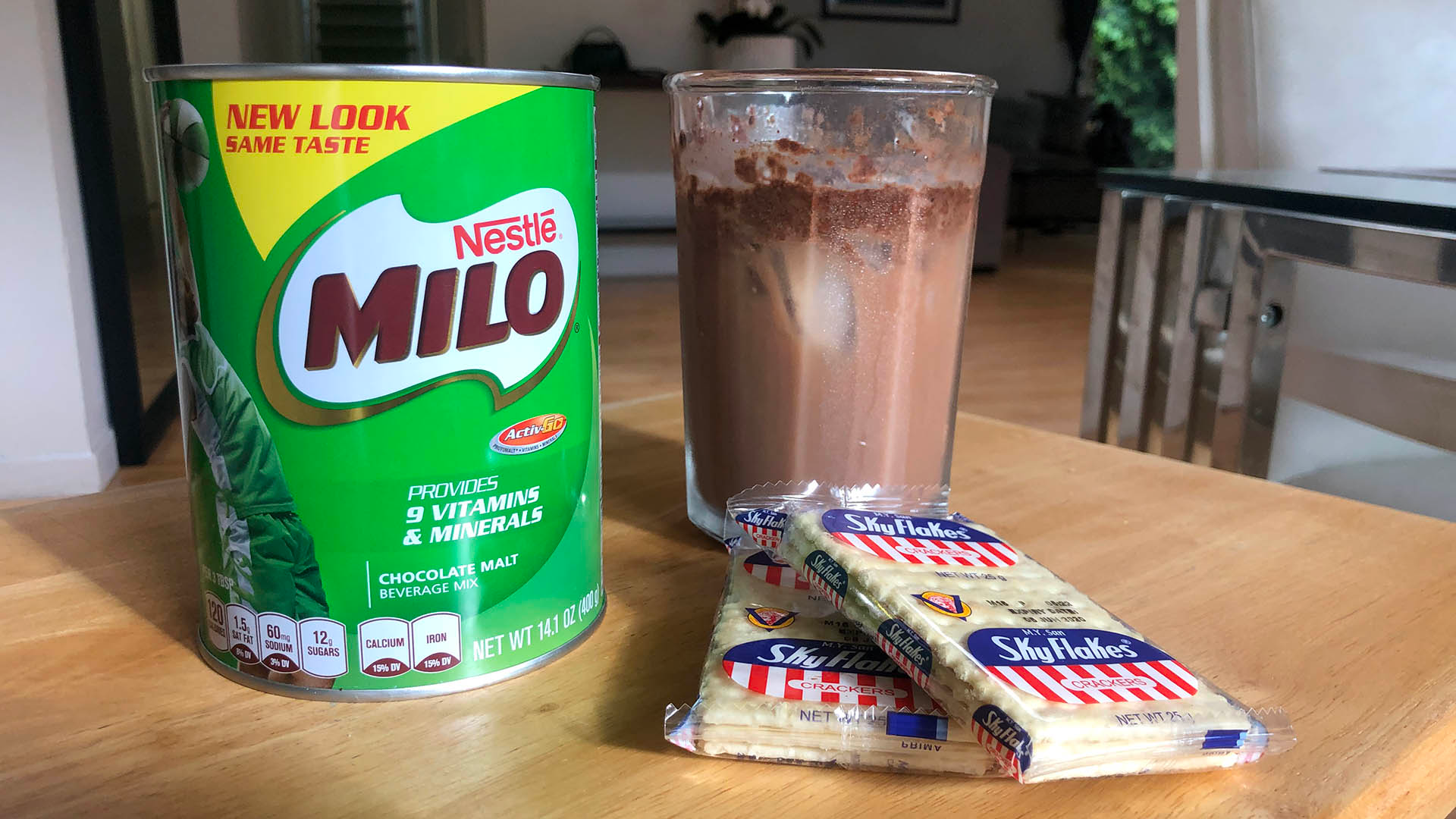Milo Is The Southeast Asian Nesquik—if Nesquik Tasted Good
Most Americans may know to sprinkle crackers into a bowl of soup, but long before I heaped a serving spoon of oyster crackers on my clam chowder at Souplantation (RIP), I first ate crackers floating atop moon-shaped refrigerator ice cubes in a cold glass of water mixed with Milo.
Milo is a milk chocolate malt powder that's popular in the Philippines, where my parents immigrated from. It tastes similar to a chocolate malt, albeit a refreshingly toned-down one with a richness that doesn't overpower you afterwards. Consider it the Southeast Asian Nesquik, without the chalky, sour aftertaste.
When washed down with a few buttery packets of Skyflakes, a Filipino saltine cracker, Milo is the taste of my childhood. It's a common snack pairing in the Philippines. Even the adults in my life couldn't resist the sweet, sweet combination of refined carbs and malted chocolate. We drank it all day, from a mid-morning merienda to a late-night snack. Though I can't remember the first time I had the drink, the distinctive bright green bag of powder was always in the pasalubong gift boxes we brought back every summer we visited my maternal grandfather in Cebu. We could get Milo in America, but it just wasn't the same. I'd oscillate between trying to make the precious light brown powder last and heaping spoonful after spoonful into my glass so that a thick, crunchy layer of malt stayed at the top for maximum goodness.
Though Milo has been sold in the Philippines since 1964, when it was first marketed as a "tonic food drink," it actually originated in Australia in the early 1930s. During the years of the Great Depression, Australian industrial chemist and food researcher Thomas Mayne tinkered away for Nestle, which hoped to develop a drink that would combat childhood malnutrition. Mayne's solution, in the end, was Milo, a vitamin-fortified, kid-friendly chocolate drink that also provided 50% of the recommended daily intake amounts of calcium, iron, and vitamin C. Among other things, it contains malted barley, dairy milk solids, cocoa, and sugar. Mayne spent a great deal of time trying to make the powder dissolve but gave up upon hearing that his children loved the crunchy top layer.
Like other food scientists at the time, Mayne was more concerned with finding ways to correct then-widespread vitamin and mineral deficiencies and general lack of nutrition by adding them to other foods (today, nutritionists typically recommend that people get their vitamins and minerals from foods where they occur naturally). In the Philippines, Milo is marketed as a chocolatey equivalent to Gatorade, and the packaging typically features sporty, active-looking children or famous athletes.
In actuality, just like Gatorade, Milo really isn't all that healthy for the average person with a sedentary activity level. In 2018, Australian health groups successfully pressured Nestle to downgrade its national Health Star Rating from 4.5 (out of 5) to 1.5, citing Milo's high sugar content. According to my can of Milo, a serving (3 tablespoons) contains 12 grams of sugar, or about half a mini can of Coke—but many people, including me, tend to measure out far more than one serving when we mix ourselves a glass. Specific formulations vary by country and can even change the powder's overall color and consistency.. Nevertheless, the drink is beloved all over the world, as comedian Jaboukie Young-White has pointed out on Twitter:
But although Milo is sold and beloved in more than 40 countries across Asia, Africa, and the Pacific, the chocolatey energy boost has never quite made it into the American mainstream. According to Nestle's U.S. spokeswoman, Nestle didn't begin importing Milo to the U.S. until about five years ago. American consumers still need to learn to appreciate the errant granules of Milo that float at the top of the drink no matter how hard you stir your water (or milk).
Every country has its own specific formulation for preparing Milo. In Bon Appetit, Rachel Khong waxes nostalgic about drinking Milo the Malaysian way, hot with a splash of milk—an experience I've maybe tried once (and didn't like). At Bluestone Lane, a Los Angeles Australian mini-chain of coffee shops, Milo is available hot or over ice, served with your choice of regular or alternative milk. There may be no universal Milo experience, but in all cases its crunchy chocolatey malt flavor is appealing in a way that Nesquik chocolate milk or Swiss Miss hot cocoa is not.
Worldwide appreciation of Milo, of course, has inspired a thousand products, from Milo ice cream bars made in Thailand, to energy cubes (which are literally just hardened squares of Milo) sold in some parts of Africa, and even chocolate bars. As dalgona coffee trended in the early days of quarantine, YouTube cooking channel Yummy Kitchen even offered up a Milo version of dalgona coffee—with extra chocolate malt powder on top, of course.
Americans are reaching for processed childhood comfort foods to cope with unprecedented fear and anxiety. For many, that might mean heating up a can of Campbell's chicken noodle soup or pouring out a bowl of cereal, but for me, the throwback treat in my back pocket will always be a tall glass of Milo and Skyflakes. As time stretches on and my personal anxiety over the pandemic subsides (even if the coronavirus itself doesn't), I know I can count on Milo to induce the sugar high I need to feel like I'm a kid again, in a world still boundlessly full of hope.
